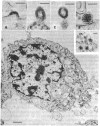The discovery of HTLV-1, the first pathogenic human retrovirus
- PMID: 26696625
- PMCID: PMC4697431
- DOI: 10.1073/pnas.1521629112
The discovery of HTLV-1, the first pathogenic human retrovirus
Abstract
After the discovery of retroviral reverse transcriptase in 1970, there was a flurry of activity, sparked by the "War on Cancer," to identify human cancer retroviruses. After many false claims resulting from various artifacts, most scientists abandoned the search, but the Gallo laboratory carried on, developing both specific assays and new cell culture methods that enabled them to report, in the accompanying 1980 PNAS paper, identification and partial characterization of human T-cell leukemia virus (HTLV; now known as HTLV-1) produced by a T-cell line from a lymphoma patient. Follow-up studies, including collaboration with the group that first identified a cluster of adult T-cell leukemia (ATL) cases in Japan, provided conclusive evidence that HTLV was the cause of this disease. HTLV-1 is now known to infect at least 4-10 million people worldwide, about 5% of whom will develop ATL. Despite intensive research, knowledge of the viral etiology has not led to improvement in treatment or outcome of ATL. However, the technology for discovery of HTLV and acknowledgment of the existence of pathogenic human retroviruses laid the technical and intellectual foundation for the discovery of the cause of AIDS soon afterward. Without this advance, our ability to diagnose and treat HIV infection most likely would have been long delayed.
Keywords: adult T-cell leukemia; human retrovirus.
Conflict of interest statement
The author declares no conflict of interest.
Figures


References
-
- Watson, JD, ed (1980) Viral Oncogenes, Cold Spring Harbor Symposia on Quantitative Biology (Cold Spring Harbor Laboratory Press, Cold Spring Harbor, NY), Vol XLIV.
-
- Epstein MA, Achong BG, Barr YM. Virus particles in cultured lymphoblasts from Burkitt’s lymphoma. Lancet. 1964;1(7335):702–703. - PubMed
-
- Heneine W, Schweizer M, Sandstrom P, Folks T. Human infection with foamy viruses. Curr Top Microbiol Immunol. 2003;277:181–196. - PubMed
-
- Brugge JS, Erikson RL. Identification of a transformation-specific antigen induced by an avian sarcoma virus. Nature. 1977;269(5626):346–348. - PubMed
Publication types
MeSH terms
Grants and funding
LinkOut - more resources
Full Text Sources
Other Literature Sources
Research Materials

